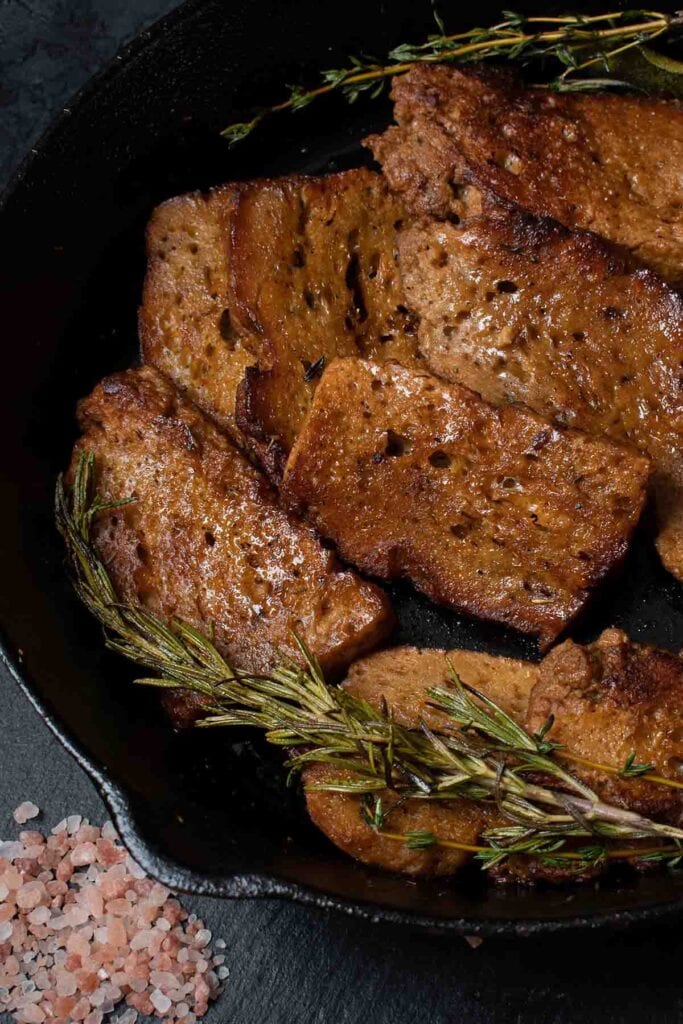My homemade seitan recipe is chewy yet tender, with a satisfying savory flavor. It’s the easiest plant-based protein to make at home, and it’s so customizable.

Once you master my basic seitan recipe, use it in vegan chili, Buddha bowls, or vegan stuffed bell peppers next!
I love experimenting with vegan proteins, especially when I can actually MAKE them from scratch. As much as I love tofu (hello, tofu scrambles!), when it comes to replicating the flavors of real beef or chicken, nothing beats seitan.
FREE EBOOK SERIES! 5 SECRETS FOR FOOLPROOF VEGAN DESERTS
Why you’ll love this recipe
- Packed with protein. Believe it or not, seitan has WAY more protein than tofu, which is perfect if you’re newly vegan and trying to meet your protein goals.
- Easier than you think. It’s as easy to make seitan dough as it is to make vegan bread.
- Super versatile. Customize this protein with an array of spices or marinades to complement what you’re serving it with.
- Perfect texture and flavor. When it comes to a vegan meat substitute, this has the closest texture to real meat, and the flavor is earthy and rich.
Key Ingredients
- Vital wheat gluten. The star ingredient! It’s made from wheat flour and provides a protein-rich base necessary for the meaty texture.
- Nutritional yeast. Adds a complex, savory flavor.
- Vegetable broth. Vegetable broth acts as a liquid component in the mixture, providing moisture. You can also use water in a pinch.
- Tamari or soy sauce. For salty, umami flavor.
- Spices and seasonings. I used garlic powder, onion powder, paprika, salt, and black pepper.
- Liquid smoke (optional). I like to add liquid smoke for a smoky flavor, mimicking the taste of smoked meat.
- Olive oil (optional). For moisture and richness. This can be swapped for any type of oil.
How to make seitan
Step 1 – Mix. Combine the wheat gluten, nutritional yeast, and spices in a large bowl. In another bowl, combine the broth, soy sauce, oil, and liquid smoke.
Step 2 – Make the dough. Add the wet ingredients to the dry and mix until a dough forms. Knead it, shape it into a log, and wrap it in aluminum foil.
Step 3 – Boil. Bring water to a boil, add the dough to the pot, lower to a simmer, and cover the pot. Let it simmer, flipping midway, until it’s fully cooked.
Step 4 – Serve. Remove the seitan from the pot, let it cool, slice, and serve.

Can I cook seitan in an Instant Pot?
Yes! If you’d rather use your pressure cooker to make seitan, here’s how:
- Place your dough into the Instant Pot, partially submerged in seasoned vegetable broth.
- Seal the lid on the pot, set it to “manual” or “pressure cook,” and cook for 10-15 minutes.
- Use the quick release venting option.
Tips to make the best seitan
- Knead the dough very well. Unlike vegan bread, you want as much gluten to develop as possible. This helps create a chewy and meaty texture. I typically knead for 5-10 minutes.
- Let the dough rest. I find this helps the gluten relax, resulting in a more tender and less rubbery texture.
- Use a steamer basket. For easier removal, you can place the wrapped seitan in a steamer basket.
- Simmer, don’t boil. It’s the slow simmering that prevents the seitan from becoming too tough or rubbery.
- Pan-fry after boiling. To get a richer, more caramelized exterior, slice the cooked seitan into thin slices, then pan-fry with oil until lightly browned on both sides.
Variations
- Vegan chicken. Swap the seasoning for poultry seasoning to replicate the flavor of chicken.
- Asian seitan. For a stir fry, marinate the seitan in a blend of soy sauce, brown sugar, rice vinegar, sesame oil, garlic, and ginger.
- BBQ flavor. Cook the seitan, then pan-fry it with Korean BBQ sauce to get a sweet, spicy, and caramelized flavor.
Storage instructions
To store: Place leftover seitan in an airtight container or wrap it in plastic wrap and place it in the fridge for 5-7 days.
To freeze: Wrap the seitan in plastic wrap or place it in a freezer-safe container and freeze for 2-3 months.
Reheating: Reheat the seitan on the stovetop over medium heat, flipping every few minutes. Or, microwave in 30-second intervals until warm.

Frequently asked questions
Vital wheat gluten is the key ingredient that gives seitan its unique texture, and I’ve yet to find a suitable replacement. If you can’t tolerate gluten, I’d suggest gluten-free meat substitutes like tofu or tempeh.
Yes, seitan is an excellent source of protein and is low in fat and carbs. It also contains essential vitamins and minerals, making it a well-rounded vegan protein choice.
Both can be part of a healthy diet, but their suitability depends on individual dietary goals. If you’re looking for a higher-protein alternative, this is great!
More protein-packed recipes to try

Seitan
Ingredients
- 1 cup vital wheat gluten
- 1/4 cup nutritional yeast
- 1 teaspoon garlic powder
- 1 teaspoon onion powder
- 1 teaspoon paprika
- 1/2 teaspoon salt
- 1/2 teaspoon black pepper
- 3/4 cup vegetable broth
- 2 tablespoons tamari or soy sauce
- 1 tablespoon olive oil optional
- 1 teaspoon liquid smoke optional
Instructions
- In a mixing bowl, combine the vital wheat gluten, nutritional yeast, garlic powder, onion powder, paprika, salt, and pepper. Stir until well combined.
- In a separate bowl, whisk together the vegetable broth, tamari or soy sauce, olive oil (if using), and liquid smoke (if using).
- Pour the wet mixture into the dry ingredients and stir to form a dough. Once the dough comes together, knead it for a few minutes to develop the gluten strands. Shape the dough into a log or desired shape, making sure it's compact and even in thickness. You can wrap the seitan in foil or cheesecloth if preferred.
- In a large pot, bring water or vegetable broth to a boil. Add the dough to the boiling liquid, reduce the heat to a simmer, and cover with a lid. Let the seitan simmer for about 1 hour, flipping it halfway through the cooking time. This helps the seitan cook evenly and absorb the flavors.
- After an hour, remove from the pot and let it cool. Once cooled, it's ready to be sliced, diced, roasted, seared, or used in your favorite recipes!
Toloc says
Crazy Vegan says